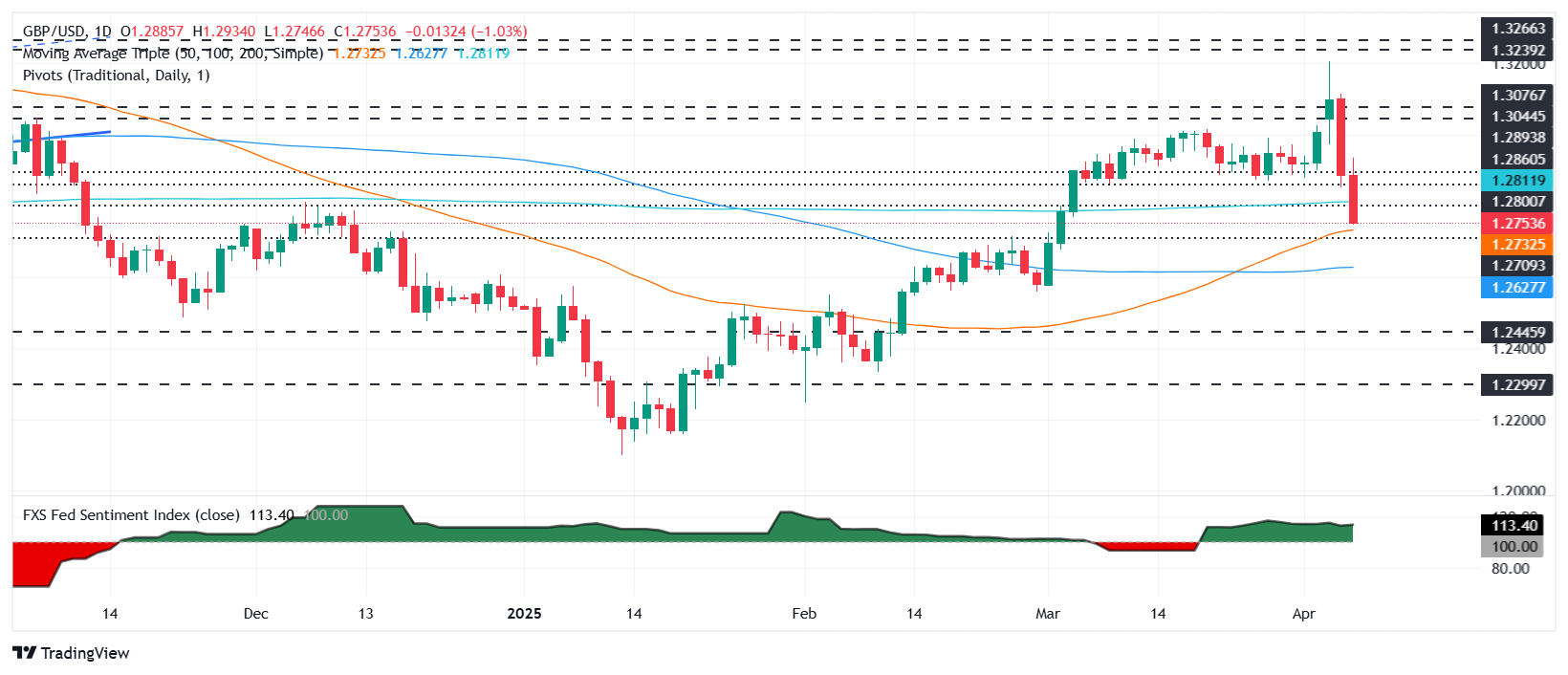- GBP/USD pukes as US tariffs spark fears of a recession.
- Sterling also falls as investors increase the chances of a BoE cut in May.
- Traders are eyeing Fed’s minutes and US CPI data.
The Pound Sterling (GBP) plunges over 100 pips or 0.90% against the Greenback at the beginning of the week, driven by recession fears and hopes cut short that the White House could reconsider their position in trade policies over the weekend. The GBP/USD pair trades at 1.2763 after hitting a daily high of 1.2933.
GBP/USD sinks to 1.2763 as risk aversion returns due to fake tariff pause headlines
Risk aversion keeps the Greenback bid on Monday. News that the White House is mulling a 90-day pause in tariffs for all nations except China, revealed by CNBC, triggered a recovery in GBP/USD, which was short-lived as Trump stated that he “did not say this.” Additionally, CNBC revealed that it was “fake news.”
Uncertainty keeps traders uneasy as US stocks have turned green recently. In the FX space, safe-haven peers are leading the gains, although traders should be aware that equities are also recovering.
Aside from this, data remains in the backseat with a scarce economic docket in the UK. Nevertheless, traders ramped up their bets that the Bank of England (BoE) would cut rates by 25 basis points in May.

Source: Prime Market Terminal
Across the pond, the US economic calendar is absent, yet traders are awaiting the release of the latest Federal Open Market Committee (FOMC) minutes and inflation data.
The Consumer Price Index (CPI) is expected to decrease from 2.8% to 2.6% year-over-year (YoY). Core CPI is projected to dip from 3.1% to 3%. An upward surprise in the data could deepen the global stocks’ rout, after Federal Reserve (Fed) Chair Powell revealed last Friday that the US central bank is in no rush to reduce borrowing costs.
GBP/USD Price Forecast: Technical outlook
GBP/USD has cleared the 200-day Simple Moving Average (SMA) of 1.2810 and aims to challenge the 50-day SMA at 1.2730. If surpassed, the next target would be the 1.2700 mark, followed by the 100-day Simple Moving Average (SMA) at 1.2627. In the surprising case of Sterling’s recovery, the first resistance would be 1.2800, followed by the 200-day SMA. Further upside is seen at 1.2900.

Pound Sterling FAQs
The Pound Sterling (GBP) is the oldest currency in the world (886 AD) and the official currency of the United Kingdom. It is the fourth most traded unit for foreign exchange (FX) in the world, accounting for 12% of all transactions, averaging $630 billion a day, according to 2022 data.
Its key trading pairs are GBP/USD, also known as ‘Cable’, which accounts for 11% of FX, GBP/JPY, or the ‘Dragon’ as it is known by traders (3%), and EUR/GBP (2%). The Pound Sterling is issued by the Bank of England (BoE).
The single most important factor influencing the value of the Pound Sterling is monetary policy decided by the Bank of England. The BoE bases its decisions on whether it has achieved its primary goal of “price stability” – a steady inflation rate of around 2%. Its primary tool for achieving this is the adjustment of interest rates.
When inflation is too high, the BoE will try to rein it in by raising interest rates, making it more expensive for people and businesses to access credit. This is generally positive for GBP, as higher interest rates make the UK a more attractive place for global investors to park their money.
When inflation falls too low it is a sign economic growth is slowing. In this scenario, the BoE will consider lowering interest rates to cheapen credit so businesses will borrow more to invest in growth-generating projects.
Data releases gauge the health of the economy and can impact the value of the Pound Sterling. Indicators such as GDP, Manufacturing and Services PMIs, and employment can all influence the direction of the GBP.
A strong economy is good for Sterling. Not only does it attract more foreign investment but it may encourage the BoE to put up interest rates, which will directly strengthen GBP. Otherwise, if economic data is weak, the Pound Sterling is likely to fall.
Another significant data release for the Pound Sterling is the Trade Balance. This indicator measures the difference between what a country earns from its exports and what it spends on imports over a given period.
If a country produces highly sought-after exports, its currency will benefit purely from the extra demand created from foreign buyers seeking to purchase these goods. Therefore, a positive net Trade Balance strengthens a currency and vice versa for a negative balance.

